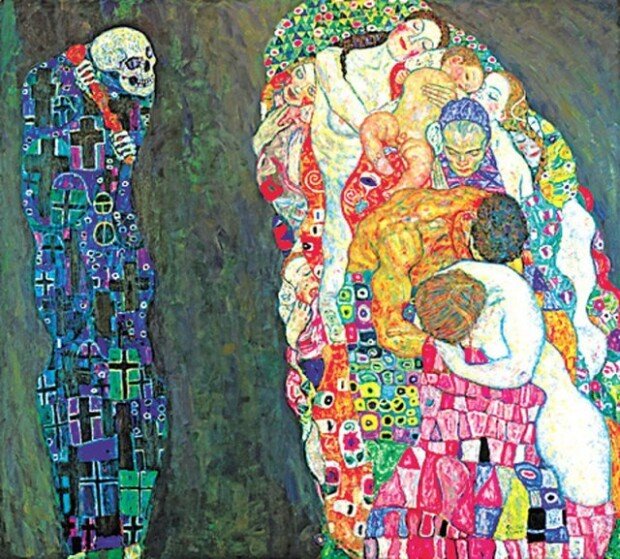The existence on the other side of life
The existence on the other side of life
Posted November. 03, 2022 07:32,
Updated November. 03, 2022 07:32

Gustave Klimt is known for his work on female nude inspired by mythology or for voracious golden-colored art. His work ‘Life and Death,’ drawn with a gray shade, was created at the peak of his popularity in his late 40s. Why did he draw the dark-themed work when he was at his best time?
Life and Death features a bold structure of the concept. On the right side, a mother and a baby, an old woman, lovers are tangled with each other surrounded by flowers. On the left side, a death stands alone, wearing a blue garment with a cross, holding a red club. It looks like an angel of death who seems to ponder upon whom he would choose to take with him.
Klimt sketched in 1908, but oil painted on a large canvas two years later. The concept of life and death was a heated topic for the people then, not just for the artist himself. It was the time the eschatology spread, and Carlos I of Portugal and his son were assassinated on the street in 1908. A destructive earthquake in Messina, Italy killed more than 80,000 people. Gustav had always feared death due to his experiences of losing his father and brother at age 30.
The artwork was submitted to the 1911 International Exhibition of Art in Rome, bringing a gold medal to its creator. Then it was exhibited in many cities in Europe and received accolades. In 1915, however, Klimt suddenly overhauled the painting. The background color was originally gold, but he changed it to dark gray as it is now and added the mosaic pattern. The feature of the death was repainted to be more active from its previous static posture. It seems the sinking of the Titanic and the death of his mother would have made him feel death more closely.
Who would not fear death? Still, the artist seemed to consider death something right beside life. That is why everyone in the picture looks serene. Three years after the art was completed, Klimt also made his journey to eternity to be with his parents.




![[단독]건보 가입자 40% 차지하는 2040세대, 병원 年 4회도 안 간다](https://dimg.donga.com/c/138/175/90/1/wps/NEWS/IMAGE/2025/12/21/133008933.1.jpg)


